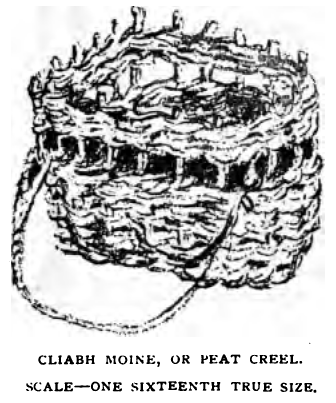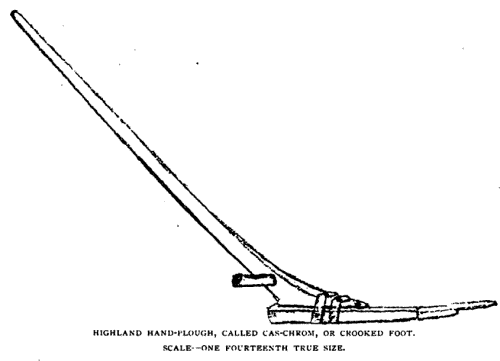THE principal sources of livelihood of the Gairloch people are their
crofts and stock and their fisheries, both treated of in separate
chapters. Of course a number of men have regular engagements, as farm or
other servants and gamekeepers; whilst a few carry on trades, as tailors,
shoemakers, weavers, boat builders, thatchers, dykers, sawyers, carpenters,
and masons.
Some young men of the parish go south, and obtain situations
either for the winter season or all the year round, and they often
contribute towards home expenses.
The women of Gairloch, like all other
Highland women, are noticeable for their industry. It is they who carry
home heavy creels of peats for the household fire,—peats in the treatment
of which they had taken an active share the previous summer; they herd the
cow, and manage the house. But, more than all, it is the women who are
mainly instrumental in producing the only manufactures of the parish, and
very excellent manufactures too they are. They card and dye and spin the
wool, they knit the Gairloch hose, and they prepare the various coloured
worsteds which the weaver converts into tweeds of different patterns.
Large numbers of the stockings are sent to Inverness, Edinburgh, and
London (see last chapter). Some of the tweeds are worn in the parish, and
some are sold to strangers.
It will be remembered that the early Pictish
inhabitants of Gairloch dwelt in the brochs or round houses of what may
almost be called the pre-historic period. These were succeeded by
turf-built huts, the roofs of which, rudely framed with boughs, were
covered with divots or turfs. The last turf house in the parish is said to
have been at Moss Bank, Poolewe, and was occupied by an uncle of John
Mackenzie (Iain Glas), whose improved dwelling stands on the same site.
The turf house was gradually replaced by the style of dwelling which now
prevails in the parish. The present cottages have their walls of stone,
the better ones cemented with lime ; the roofs of timber, thatched with
heather, rushes, or straw; divots are also still frequently used in
roofing. Some few superior crofters' houses have slated roofs, and modern
grates with flues and regular chimneys. But many of the crofters still
have their byres under the. same roof; still have no chimney in the living
room, whence the smoke from the peat fire escapes only by a hole in the
roof; and still have the heap of ashes, slops, manure, and refuse just
outside the door. Sir Francis Mackenzie, in his "Hints" (1838), has some
suggestive remarks on the subject of these dwellings. He writes:—"I must
at once protest against human beings and cattle entering together in your
present fashion at the same doorway. . . . I will not raise a laugh at
your expense by describing your present smoky dens, and the hole in the
roof with sometimes an old creel stuck on it in imitation of a chimney.
The smoke you now live in not only dirties and destroys your clothes and
furniture, but soon reduces the prettiest rosy faces in the world to
premature wrinkles and deformities. . . . Let there be no apology for want
of time for carrying away ashes, sweepings, or dirty water, and adding
them to your dunghill, instead of sweeping all into a corner till you have
more time, and emptying the dirty water at your door because you are too
lazy to go a few yards farther."
The houses of the crofters are
certainly undergoing gradual improvement, but the majority cling
tenaciously to the type of dwelling their fathers occupied before them.
Perhaps the villages of Strath, Poolewe, and Port-Henderson contain the
most improved houses in the parish. Very few of the crofters — have
gardens worthy of the name, so that, of course, they lose the advantage of
green vegetables and fresh fruits. Still more rare is it to see trees
planted about their dwellings, though pleasant shade and shelter might
thus be had, and though, it is understood, saplings might be obtained for
the asking from the proprietors.
 As a natural
consequence of the proximity of middens to dwelling-houses, and other
unhealthy arrangements, cases of fever occasionally occur. In the Old
Statistical Account, 1792 (Appendix C), the writer, speaking of Gairloch,
says that fevers were frequent, and an infectious putrid fever early in
the preceding winter had proved fatal to many. Pennant had previously
noticed how spring fever used to decimate the west coast. Such outbreaks
have happily become rare since the potato famine of 1847 led the people to
depend more on imported meal for their sustenance in spring.
As a natural
consequence of the proximity of middens to dwelling-houses, and other
unhealthy arrangements, cases of fever occasionally occur. In the Old
Statistical Account, 1792 (Appendix C), the writer, speaking of Gairloch,
says that fevers were frequent, and an infectious putrid fever early in
the preceding winter had proved fatal to many. Pennant had previously
noticed how spring fever used to decimate the west coast. Such outbreaks
have happily become rare since the potato famine of 1847 led the people to
depend more on imported meal for their sustenance in spring.
Few of the
crofters' houses are floored, so that the inmates stand on the natural
ground, or put their feet on a loose plank. In wet weather the ground
often becomes 1 damp. From this and other local causes pulmonary
consumption is common among the crofter class. It is only right to add
that this fatal disease often appears among some of the young people who
go to work in southern towns, and come home to die.
Smallpox is said to
have been fatal in Gairloch in the eighteenth century, at the time when it
ravaged the adjoining parish of Applecross. The soubriquet "breac" (i.e.
pock-pitted), so often met with in the history of Gairloch, is an evidence
of the former frequency of this epidemic. Thanks to vaccination, it is now
almost unknown.
The chief articles of diet of the crofter population are
scale-fish, either fresh or cured, oatmeal, potatoes, and milk, "'"" "
with a little butcher meat occasionally. Eggs are not much eaten, but are
exported to Glasgow in considerable quantities. None of the crofters keep
pigs, which they consider to be unclean beasts; it is singular they should
entirely neglect a source of food and profit so universal among their
Irish congeners. Captain Burt, in his day, noticed the absence of swine
among the mountains; he said, "those people have no offal wherewith to
feed them ; and were they to give them other food, one single sow would
devour all the provisions of a family."
The principal intoxicating
beverage in Gairloch is whisky. Very little beer is consumed by the
natives. Whisky became known in the Highlands during the sixteenth
century, and soon found its way to Gairloch; but it is said that the mania
for illicit distillation did not reach the parish until the year 1800. The
first whisky was distilled in Gairloch by the grandfather of Alexander
Cameron, the Tournaig bard, in Bruachaig, on the way up to the heights of
Kenlochewe. The mother of George Maclennan, of Londubh, was at that time
servant at the Kenlochewe inn, and long afterwards told her son how the
innkeeper bought the whisky and the plant as well.
James Mackenzie says
that it was in his father's house at Mellon Charles, in the same year
(1800), that the first Gairloch whisky was made by a stranger, who had
craved and obtained his father's hospitality. Probably both accounts are
correct, but it is impossible at this distance of time to determine to
whom the questionable honour of having commenced the illicit distillation
of whisky ought to be assigned. The mania for smuggled whisky spread very
rapidly throughout the parish, and is not yet extinct. The larger islands
of Loch Maree were the scenes of illicit distillation in the early part of
the nineteenth century. They say a regular periodical market for the sale
of whisky made on the islands, used to be held at the large square stone
on the shore of Loch Maree between Ardlair and Rudha Cailleach, called
Clach a Mhail (see illustration).
 Peats are
the only fuel used by the crofter population; they are cut from the
peat-mosses by means of an instrument admirably adapted for the purpose,
called the "torasgian," or peat knife (see illustration). Before the
cutting is commenced, a spit of turf is removed from the surface of the
ground by another implement called the "cabar lar," or turf-parer (see
illustration). Each tenant has a portion of a convenient peatmoss allotted
to him. The peats are K ^BirfS^ cut wnen tne spring work is over,—
Peats are
the only fuel used by the crofter population; they are cut from the
peat-mosses by means of an instrument admirably adapted for the purpose,
called the "torasgian," or peat knife (see illustration). Before the
cutting is commenced, a spit of turf is removed from the surface of the
ground by another implement called the "cabar lar," or turf-parer (see
illustration). Each tenant has a portion of a convenient peatmoss allotted
to him. The peats are K ^BirfS^ cut wnen tne spring work is over,—
in
April, May, or June, — if the weather permit. After being cut the peats
are reared on end to dry, and when thoroughly dried are stacked for use.
The stacks are ingeniously constructed, with the outside peats sloping
downwards, so as to throw off rain-water. Some twenty years ago there was
a season of such continuous wet weather that the peats never dried, and
the people were put to great straits to keep themselves warm during the
succeeding winter.
The peat creel (see illustration), called in Gaelic "cliabh
moine," is used for bringing home supplies of peat as needed. Creels are
made by the people of willow and birch twigs.
There are very few carts
among the crofters, and they have no other vehicles.
Dr Mackenzie gives
the following account of the curious sledges which were used in Gairloch
instead of wheeled carts in the beginning of the nineteenth century:—"
There being no need of wheels in a roadless country, although we had a
six-mile road to the big loch [Loch Maree] and another six miles to its
exit at the sea [at Poolewe], we had only sledges (in place of wheeled
carts), all made by our farm-bailiff or grieve. He took two birch trees of
the most suitable bends, and of them made the two shafts, with ironwork to
suit the harness of back belts and collar-straps. The ends of the shafts
were sliced away with an adze at the proper angle to slide easily and
smoothly on the ground. Two planks, one behind the horse and the other
about a foot from the shaft-ends, were securely nailed to the shaft, and
bored with many augur-holes to receive many four-feet long hazel rungs to
form front and back of the cart to keep in the goods, a similar plank atop
of the rungs, making the front and rear of the cart surprisingly stiff and
upright. The floor was made of planks, and these sledge-carts did all that
was needed in moving crop of most kinds. I think moveable boxes, planted
on the sledge-floor between the front and rear hazel rod palings, served
to carry up fish from the shore, lime, and manure, &c. And it was long ere
my father [Sir Hector Mackenzie of Gairloch] paid a penny a year to a
cartwright."


